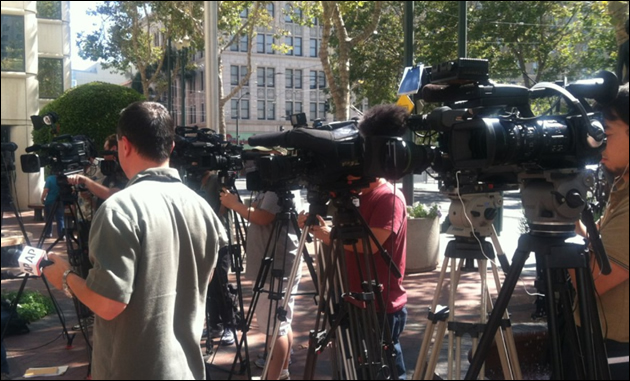After a month-long trial and two days of deliberations, a nine-person jury has found Samsung guilty of “willfully infringing” on Apple patents and copying Apple’s iPhone and iPad designs for Samsung’s Galaxy series phones and tablets.
In finally closing the landmark patent battle case at the U.S. District Court in San Jose, California, Judge Lucy Koh ordered Samsung to pay Apple more than $1 billion in damages — or more precisely, $1,049,343,540.
 The case centered on a handful of patents that cover the look and feel of the iPhone and iPad and some icons on the devices’ home screens. Apple alleged that Samsung sold 22.7 million cellphones in the U.S. since June 2010 that infringe on its patents, and was seeking up to $2.75 billion in damages.
The case centered on a handful of patents that cover the look and feel of the iPhone and iPad and some icons on the devices’ home screens. Apple alleged that Samsung sold 22.7 million cellphones in the U.S. since June 2010 that infringe on its patents, and was seeking up to $2.75 billion in damages.
According to The Verge, which had reporters in the courtroom, the jury found that a huge number of Samsung devices illegally copied ideas from Apple’s software interface — most notably, bounce-back scrolling and gestures. The list of Samsung devices in violation includes the Continuum, Droid Charge, Exhibit 4G, Fascinate, Galaxy Ace, S II, Galaxy Prevail, Galaxy S 4G, Galaxy S II, i9100, Galaxy S 2 T-Mobile, Tab, Galaxy Tab, Gem, Indulge, Infuse 4G, Mesmerize, Nexus S 4G, Prevail, Replenish and Vibrant Captivate, and many others.
Even more importantly, the following devices were found to infringe upon Apple’s “front trade dress” or design aesthetic patents: Fascinate, Galaxy S, S 4G, S 2 ATT, S2 i9100, S2 T-Mobile, S 2 Epic 4G touch, Infuse 4G, Mesmerize, Skyrocket, Showcase, and Vibrant.
Samsung won a small consolation in that the jury found its Galaxy Tab tablet was found not to infringe on Apple’s “front trade dress” patents.
Among the damaging documents produced by Apple prosecutors was an internal Samsung analysis produced in 2007 that detailed the iPhone’s strengths, as well as press reports that trumpeted the iPhone’s “revolutionary” design.
For Samsung’s part, its lawyer Charles Verhoeven never argued that the phones weren’t similar. Instead, he countered that similarities in the design were due to natural product evolution in the phone industry and that Apple’s iProducts are not unique. The company also showed evidence that it worked very hard to develop its products from early on.
Apple responded by presenting the internal documents that showed Samsung comparing its icons to the iPhone.
As part of the very complex verdict, the jury had to decide on more than 700 individual allegations, and needed an extra day for its deliberations. Samsung will likely appeal, and the Korean company continues to battle Apple in court in similar cases in several other countries.
Samsung responded to the verdict with this official statement: “Today’s verdict should not be viewed as a win for Apple, but as a loss for the American consumer. It will lead to fewer choices, less innovation, and potentially higher prices. It is unfortunate that patent law can be manipulated to give one company a monopoly over rectangles with rounded corners, or technology that is being improved every day by Samsung and other companies. Consumers have the right to choices, and they know what they are buying when they purchase Samsung products. This is not the final word in this case or in battles being waged in courts and tribunals around the world, some of which have already rejected many of Apple’s claims. Samsung will continue to innovate and offer choices for the consumer.”





